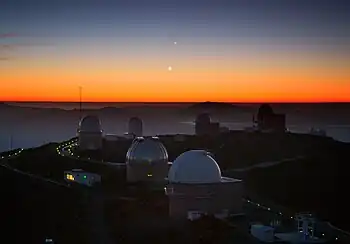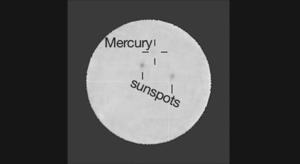
In astronomy, a syzygy (/ˈsɪzədʒi/ SIZ-ə-jee; from Ancient Greek συζυγία (suzugía) 'union, yoke')[1] is a roughly straight-line configuration of three or more celestial bodies in a gravitational system.[2]
The word is often used in reference to the Sun, Earth, and either the Moon or a planet, where the latter is in conjunction or opposition. Solar and lunar eclipses occur at times of syzygy, as do transits and occultations. The term is often applied when the Sun and Moon are in conjunction (new moon) or opposition (full moon).[3]
When Earth is one of the bodies involved, the other objects appear to be close together (or overlapping) in the sky.

Main types
A syzygy sometimes results in an occultation, transit, or an eclipse.
- An occultation occurs when an apparently larger body passes in front of an apparently smaller one.
- A transit occurs when a smaller body passes in front of a larger one.
- In the combined case where the smaller body regularly transits the larger, an occultation is also termed a secondary eclipse.
- An eclipse occurs when a body totally or partially disappears from view, either by an occultation, as with a solar eclipse, or by passing into the shadow of another body, as with a lunar eclipse (thus both are listed on NASA's eclipse page).
Consequences
Einstein ring
As electromagnetic rays are affected by gravitation, when they pass by a heavy mass they are bent. As a result, the heavy mass acts as a form of gravitational lens. If the light source, the gravitating mass and the observer stand in a line, one sees what is termed an Einstein ring.
Tidal variation
A syzygy causes the fortnightly phenomena of spring and neap tides. At the new and full moon, the Sun and Moon are in syzygy. Their tidal forces act to reinforce each other, and the ocean both rises higher and falls lower than the average. Conversely, at the first and third quarter, the Sun and Moon are at right angles, their tidal forces counteract each other, and the tidal range is smaller than average.[5] Tidal variations can also be measured in the Earth's crust, and these Earth tide influences may affect the frequency of earthquakes.
Extraterrestrial cases
The word syzygy is often used to describe interesting configurations of astronomical objects in general. For example, one such case occurred on March 21, 1894, around 23:00 GMT, when Mercury transited the Sun as would have been seen from Venus, and Mercury and Venus both simultaneously transited the Sun as seen from Saturn.

On June 3, 2014, the Curiosity rover on Mars observed the planet Mercury transiting the Sun, marking the first time a planetary transit has been observed from a celestial body besides Earth.[6]
Other uses
The term is also used to describe situations when all the planets are on the same side of the Sun although they are not necessarily in a straight line, such as on March 10, 1982.[7]

Because the orbits of all the planets in the Solar System (as well as the Moon) are inclined by only a few degrees, they always appear very near the ecliptic in our sky. Therefore, although an apparent planetary alignment may appear as a line (actually, a great arc), the planets are not necessarily aligned in space.
References
- ↑ "syzygy". CollinsDictionary.com. HarperCollins. Retrieved 22 August 2012.
- ↑ "Syzygy". Glossary, The Astronomical Almanac Online. HM Nautical Almanac Office and United States Naval Observatory. 2012. Archived from the original on 2013-06-15. Retrieved 2012-09-13.
- ↑ Coyle, Harold P. (2008). "Syzygy". AccessScience. ©McGraw-Hill Companies. doi:10.1036/1097-8542.757218. Retrieved May 5, 2012.
- ↑ "Three Planets Dance Over La Silla". ESO Picture of the Week. Retrieved 5 June 2013.
- ↑ Matt Rosenberg. "Tides: The Sun and Moon Affect the Oceans". Retrieved May 10, 2012.
- 1 2 Webster, Guy (June 10, 2014). "Mercury Passes in Front of the Sun, as Seen From Mars". NASA. Retrieved June 10, 2014.
- ↑ "Ideas & Trends in Summary; It's All Right To Come Out Now". New York Times. March 14, 1982. Retrieved May 20, 2015.
